For many, the Barossa is synonymous with Australian red wine, such is its history and global reputation. At the same time, it is also often maligned in the modern wine world as home of a winemaking style that has had its day. In just one day I wanted to dip my toe into this iconic region and find out what is really going on.
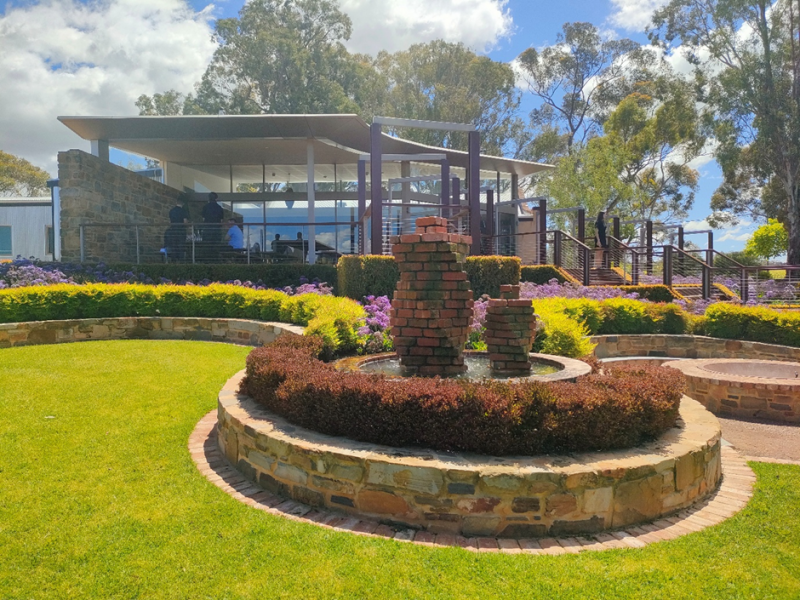
The beautifully landscaped Torbreck cellar door and gardens
First, a little history. As James Halliday notes, while Australia now prides itself as a multicultural society, the Barossa Valley was already multicultural by the 1850s. Among British forebears of famous wineries are George Fife Angas (Angaston) Joseph Gilbert (Pewsey Vale), Samuel Smith (Yalumba) and William Salter (Saltram). Prussian pioneers include Johann Gramp and William Jacob (Orlando, Jacobs Creek) Joseph Seppelt (Seppeltsfield). Vine growers from these two backgrounds established extensive plantings which by the end of the 19th century and continuing until the middle of the 20th century comprised 70% Shiraz, Grenache and Mataro (Mourvedre). Today the Barossa Valley has sixth generation winegrowing families with blocks of vines that are over 150 years old, some of the oldest vines in the world, enabled by very strict bio-security measures since the late 1800s.
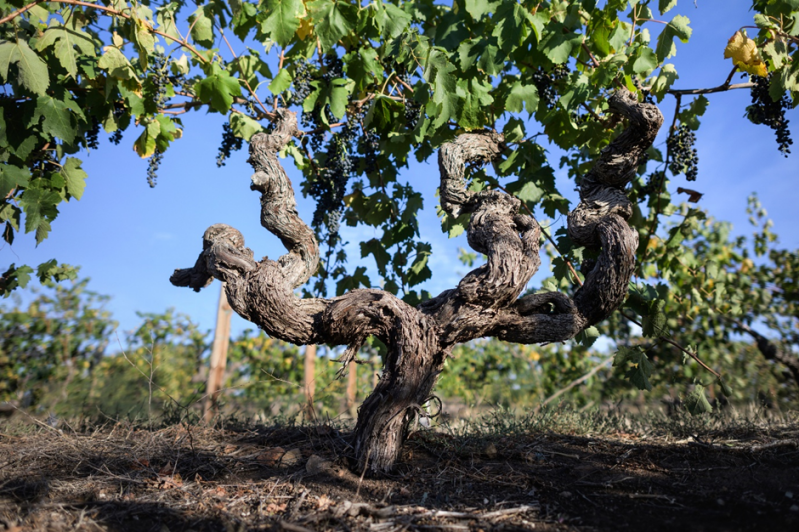
Torbreck Old Vine
Like most great winegrowing regions, the history of Barossa’s success is far from linear. There were problems of overproduction as early as 1860, as well as in the 1930s and again, almost catastrophically so in the 1970s when a state funded vine-pull scheme threatened the very survival of those now highly valued ancient vines. Second and third generation vignerons of German heritage were interned during World War 1. Huge changes in wine drinking fashion have had an impact, particularly the growing popularity of white table wines over red, as has the relentless contraction of the market for fortified wines, and the turning away from the big heavy styles of red once popular in Barossa to lighter styles from new cooler climate wine regions. Industry consolidation that saw family estates gobbled by multinationals also had some undesirable consequences, risking a loss of local identity, maximising volume and homogeneity over terroir, and undermining sustainability initiatives. Yet through it all the Barossa has emerged with pride and confidence and remains home to many iconic producers and wines.
Torbreck’s winery, nestled in the heart of the Barossa Valley, is a beacon of old-vine heritage, Rhône-inspired winemaking, and passionate custodianship. When you step onto the grounds of Torbreck Vintners, you’re entering a story that spans centuries and continents. Though the winery itself was founded in 1994 by David Powell, its soul lies in the Barossa Valley’s ancient vines, some planted as early as the 1840s. The name “Torbreck” pays homage to a forest in Scotland where Powell once worked as a lumberjack—a nod to the rugged romance that still infuses the estate’s ethos.
Torbreck’s journey has been anything but linear. After early acclaim—including a breakout moment when the 1996 RunRig was lauded by The Wine Advocate—the winery faced financial turmoil and changed hands multiple times. In 2008, American entrepreneur Pete Kight, owner of Quivira Winery in Sonoma, acquired Torbreck, ushering in a new era of stability and vision. Today, the estate is led by Pete and Terri Kight, with Ian Hongell—formerly of Peter Lehmann—serving as Chief Winemaker and General Manager.
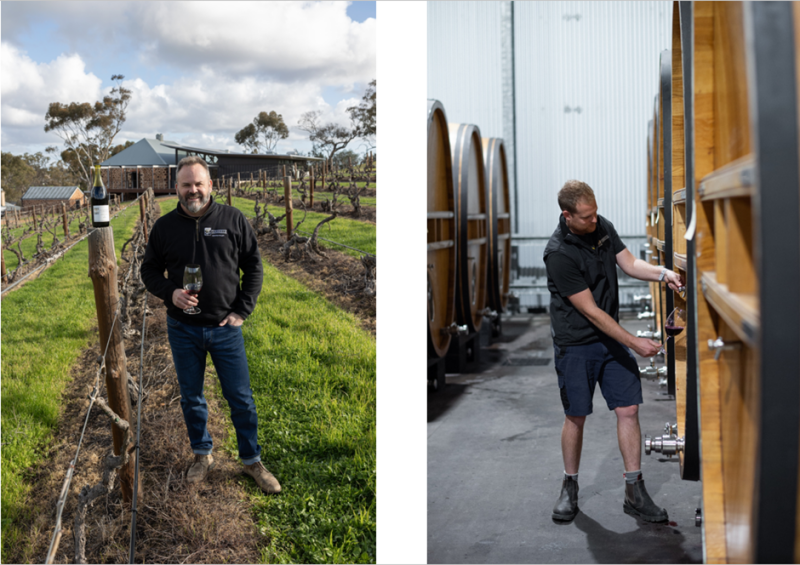
Left. Ian Hongell, Torbreck GM & Chief Winemaker. Right. Scott McDonald, Winemaker.
Torbreck’s focus remains steadfast: to honour the Barossa’s old vines and Rhône varietals like Shiraz, Grenache, and Mataró, alongside whites such as Marsanne, Roussanne, and Viognier. The winemaking philosophy is one of minimal intervention, allowing the vineyard’s voice to shine through. Fruit is sourced from exceptional parcels across the Barossa, wines are bottled with no fining or filtration, and maturation is dictated by the wine’s natural rhythm—not a calendar.
Recent milestones include the resurrection of the Hillside Vineyard, where vines planted in the 1850s have been lovingly restored, culminating in the release of The Forebear—a tribute to the estate’s enduring legacy and commitment to terroir.
Torbreck owns five vineyards spread across a 20km-long north-south ridge on the western edge of the Barossa Valley one of which is the above-mentioned Hillside. In addition, Torbreck works in partnership with a number of growers in the Valley. The winemaking approach is one of minimal intervention and respect of origin. There is no fining or filtration of the wines and barrel maturation is for as long as the wine needs rather than formulaic.
Torbreck was already on my radar but came into sharper focus when in 2019 it acquired from Martinborough ‘Prince of Pinot’ Larry McKenna, the highly regarded local Escarpment Wines. I have observed with interest the significant investment in Escarpment by Torbreck, including a new winery and cellar door, while at the same time noting they seem to have encouraged Escarpment to continue their unique and confident self-direction – not always the case with overseas owners! Tim Bourne, Winemaker at Escarpment introduced me to Torbreck’s Direct Sales and Brand Manager, Michael Van Der Sommen who kindly hosted my tour.
We commenced with a tour of the impressive winery, talking about the vineyards and current sustainability initiatives before spending some time in the barrel room. Here we tasted samples of Grenache, Shiraz and Mataro (Mourvèdre) from the oak foudres pictured below, before an on-the-spot blend Michael prepared to illustrate the different qualities each grape variety provide to a GSM blend such as The Steading.
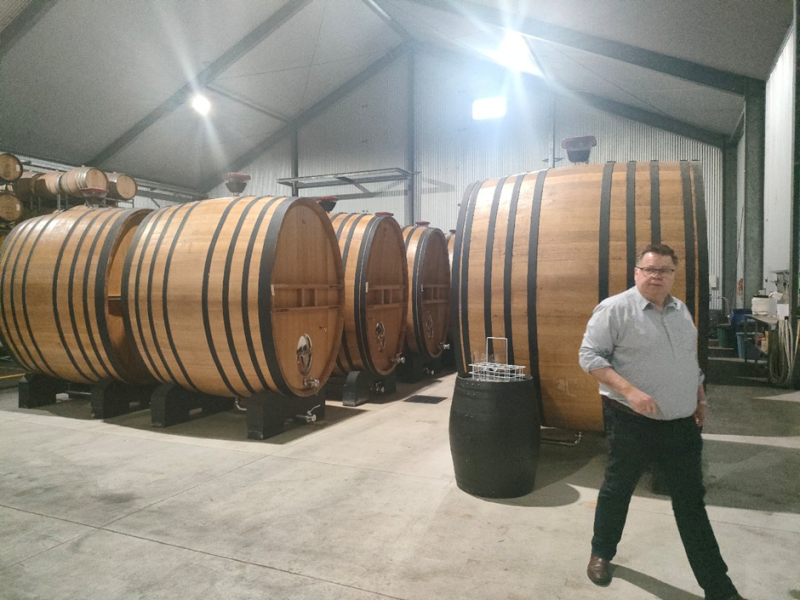
Inside the barrel room of Torbreck’s winery with Michael
From there we returned to the splendid cellar door for a guided tasting through the iconic Collector’s wines as follows:
Les Amis 2022 Grenache. What a stunning beginning! From a single vineyard of old Grenache vines, the wine matured in oak barriques 30-40% new. Deep ruby in the glass with distinct aromas of dark plums, sweet cherry and strawberry compote overlaid with lavender, roasting pan and savoury spice. On the palate it is rich and plush with ripe red fruit, mocha oak and olive tapenade, the firm but velvety tannins drive to a long and satisfying finish. Enjoyable now but will age for twenty years.
The Steading 2023 GSM. A blend of 57% Grenache, 33% Shiraz and 10% Mataro sourced from old vines and multiple sources including Torbreck’s own vineyards as well as contracted growers in a cooler season, hand harvested, destemmed and fermented in open top fermenters before pressing and aging in the seasoned oak foudres shown above, then final blending. Deep ruby with intense red fruit aromas overlaid with Moroccan spices and meaty notes,and a touch of pot-pourri. Rich and plush on the palate with sweet red berries, dark chocolate and baking spice, and soft fine tannins.
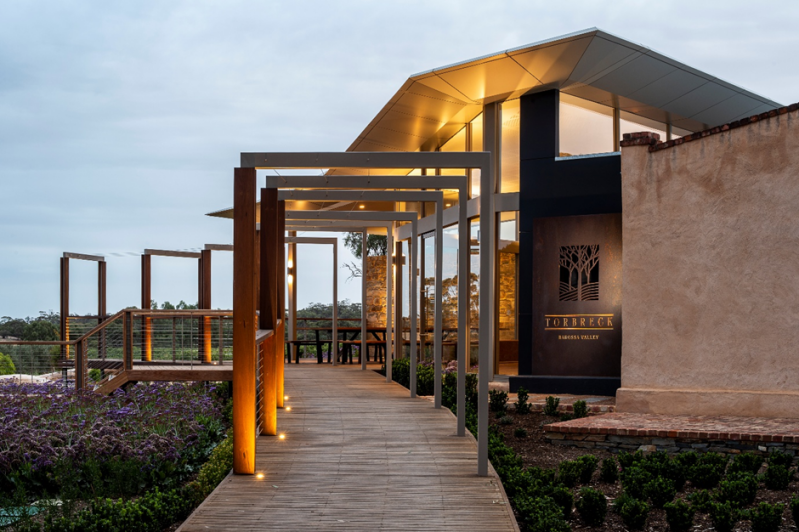
Torbreck Cellar Door
The Struie 2023 Shiraz. A blend of fruit from 40-year-old vines in the Eden Valley and 80-year-old vines in the Barossa, balancing the structure, elegance and spice of Eden with the muscular power of Barossa. Inky magenta purple in the glass with blackberry, ripe plum, blueberry, violets and spice on the nose. On the palate plush velvety tannins with dark plum, blackberry and chocolate flavours, lush and long with a distinct meaty edge.
The Gask 2023 Shiraz. From elevated Eden Valley sites of old vine Shiraz. Magenta purple in the glass and distinctly perfumed with violets, pot pourri and black pepper spice giving way to dark berry fruit and crushed rock aromas. The palate is plush with blackberry and dark chocolate but lighter-bodied and more elegant than the Struie, with a fresher acidity that gives a fine lifted finish.
The Descendant 2022 Shiraz. From vines planted in 1994, propagated with cuttings from the very old RunRig grower vineyards, co-fermented with Viognier (8%) from vines interplanted in the same vineyard in the style of Northern Rhone. Fermented in open top fermenters and basket pressed to second use oak barriques previously used for the flagship RunRig for 20 months ageing. Inky magenta purple in the glass with lifted aromas of violets, white pepper, dark berry, plum and olive tapenade. A rich and creamy palate with superfine but still chewy tannins and Moroccan spice edged black and blue fruit on the long finish.
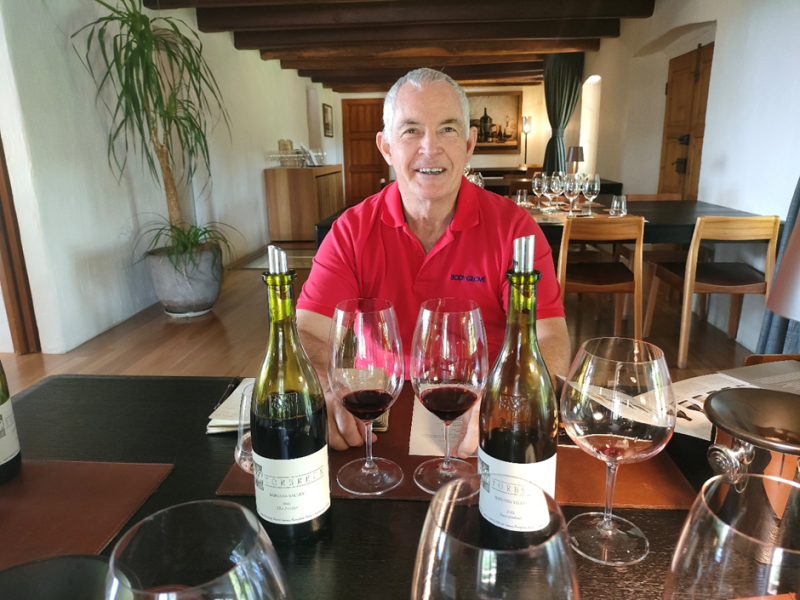
Tasting the Descendant Shiraz and The Factor Shiraz side by side
The Factor 2022 Shiraz. Old-vine Shiraz from vineyards along the Barossa’s western ridge, hand harvested and fermented in open-top fermenters before basket pressing and maturation for 24 months in a combination of new and seasoned French oak barrels. A classic big Barossa styled wine, inky purple in the glass with aromas of black and blue fruits, vanilla, mocha chocolate and cured meat aromas with some brown spice. The palate is lush and viscous with a considerable depth and concentration of rich dark berry fruits well-framed by fine tannins and a long, balanced finish.
RunRig 2022 Shiraz. Shiraz from six vineyard in the Barossa with old vine, some more than 170 years old. Hand harvested and destemmed fruit fermented separately in open top fermenters and after basket pressing the wine was aged in a mix of new and seasoned oak barriques for 30 months with 2% Viognier added prior to the final blend before bottling. Deep inky purples to the rim of the glass with lifted aromas of pot-pourri overlaying blackberry compote, dark chocolate, cinnamon and clove with some dried rosemary as well. On the weighty palate lush, sweet berry fruits meld seamlessly with dark chocolate, vanilla and gentle brown spice, with a muscular power that still has the lightness of a young Muhammad Ali’s footwork. Already approachable but will age gracefully for decades.

The lineup of Torbreck wines tasted
RunRig 2016 Shiraz. A privilege to taste this wine with almost ten years of bottle age. In the glass still deep, purple-tinted ruby, with intense aromas of ripe black fruit, smoky bacon, liquorice, and dried herbs. The palate unfolds in layer upon layer of intense, ripe blackberry, raspberry and black cherry fruit with milk chocolate and gentle baking spice, that liquorice again, and some dark olive, the finish is so rich and long and lingering. A magnificent conclusion to a wonderful tour and tasting experience.
At a time when traditional red wines are declining in popularity, Torbreck has not lost its nerve and maintains a relentless focus on expressing the quality of some of the world’s oldest vines while embracing incremental improvement. It remains true to the Torbeck approach of late picking and dry farming combined with rigorous vine management to ensure there are no cooked flavours in the concentrated fruit and the rich wines retain balance and freshness. My overall impression is that they are succeeding, and these high alcohol, powerfully fruited wines still retain seductive aromatics, balance and finesse.
If my Torbreck visit was an opportunity for a deep dive into one renowned producer, my next visit to Artisans of Barossa provided a time efficient way to get a broad view. Artisans of Barossa is a collaborative project founded 25 years ago with seven exceptional small Barossa winemakers including some of the most famous Barossa personalities. Their philosophy is expressed on their website in these terms:
“To be an ‘artisan’ is very much about setting your own path driven by a human desire to explore, experiment and to express ourselves. To create and share things shaped in our mind and made by our own hands for the enjoyment of others.”
The Artisans of Barossa are John Duval Wines, Spinifex Wines, Sons of Eden, Lienert Vineyards, Schwarz Wine Co., Hobbs of Barossa Ranges and Chaffey Bros. Wine Co. In their cellar door over 100 small-batch wines are available, and there is also an excellent restaurant, where I enjoyed lunch before my next appointment.

Artisans of Barossa Cellar Door main entrance
Wine Room Manager Manpreet Singh guided me through a tasting of exemplary wines to showcase their work, as follows.
Sons of Eden, Cirrus 2021 Eden Valley Riesling. The “Sons of Eden” are winemaker Corey Ryan who has an impressive resume including Villa Maria in NZ and Henschke in the Eden Valley along with recognition as NZ Winemaker of the Year in 2001 and was a Finalist in the 2016 Gourmet Traveller Australian Winemaker of the Year, together with Simon Cowham, winemaker and viticulturist with a resume including viticulturist for Yalumba and recognition by Barons of Barossa as Barossa Winemaker of the Year in 2013. The wine is from handpicked grapes grown in a high-altitude Eden Valley vineyard with shallow sandy loam and schist over granite bedrock soil, 100% whole bunch pressed and only the best free run taken for a cool ferment to dry, followed by 4 months on lees before bottling, then held 36 months before release. Green-tinged straw in the glass with lime citrus on the nose and subtle white flower and honeysuckle hints. On the palate surprisingly soft and sleek with gentle phenolics supplying a beautiful balance to the tangy acidity, finishing long dry and citrusy.
Spinifex Lola 2024 Barossa White Blend. Spinifex was founded by Peter Schell and Magali Gely in 2001 bringing a strong French influence, with Magali coming from a long line of Languedoc vignerons and Peter having spent much of his career working vintage in various parts of France. The wine is a blend of 91% Semillon with 6% Clairette and 3% Grenache Gris from handpicked fruit with some skin contact. Lemon in the glass with distinct aromas of lemon wax, mandarin peel, yellow peach and green mango, perhaps a faint whiff of smoke. On the palate a lovely sweet-fruited entry of pear and lemon curd unfolds to a herbal edged papaya and salted almonds with a waxy, slightly phenolic and very satisfying finish. Small amounts of the Rhone whites in the blend have a big impact!
Spinifex La Cigale 2022 Barossa Red Blend. The wine is intended to be an unpretentious and casual red inspired by long working lunches in Provence vineyards, a blend of 56% Mataro, 24% Cinsault and 20% Grenache. Light ruby in the glass with red fruit, lavender and spice aromas. The light-bodied and fresh palate surprised me given the proportion of Mataro, with ripe plum, cherry and raspberry fruit, soft tannins, perfectly judged acidity and sweet baking spices, the finish quite long and layered. Very smart! This would have been my pick to drink with the duck confit I had for lunch later in the restaurant.
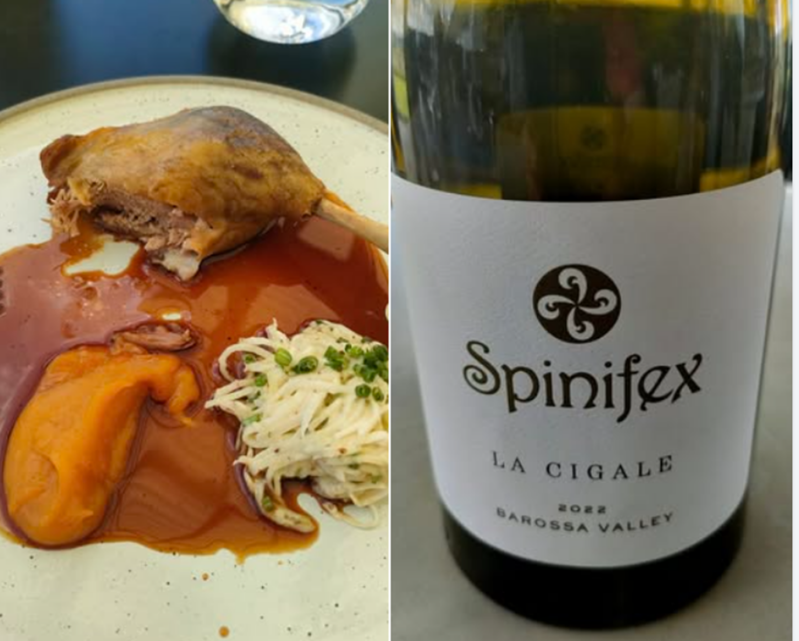
John Duval Eligo 2021 Barossa Shiraz. John Duval’s family supplied grapes to some of South Australia’s top wineries including Penfolds where John served as only the third Chief Winemaker following Max Schubert and Don Ditter. After 29 years at Penfolds John launched his own personal wine project John Duval Wines in 2003 and the first Eligo was made in 2005. The aim is to continue the story of his SA wine family by producing structured and elegant wines made from fruit grow in exceptional old Barossa vineyards. This wine exemplifies that theme and come from 62% Barossa old vines and 38% Eden Valley and spent 20 months in oak 40% new. Inky purple in the glass with aromas of violets, blackberry, smoky bacon and cloves. On the palate it is rich and lush with ripe dark plum and blackberry flavours supported by notes of dark chocolate and liquorice, and soft chalky tannins, the flavour just goes on and on.
Schwarz Wine The Schiller 2021 Barossa Shiraz. Schwarz Wine Co was founded by Jason Schwarz in 2001 initially with grapes purchased from his parents and subsequently other growers as well. Their wines are described as “new-age expressions of Barossa classics, designed to let the fruit speak for itself and tell a story through the glass”. This wine is from 400 Barossa vines planted in 1881 and spent 21 months in oak 50% new. Magenta purple in the glass with aromas of sweet blackberry, black pepper and cinnamon spice and juniper. Plush and juicy with black fruits, liquorice, baking spices and chocolate, the tannins firm but fine, the finish long, powerful yet balanced.

One corner of the Sons of Artisan tasting area
Chaffey Bros Elijah 2021 Fechner Vineyard Eden Valley Shiraz. Chaffey Bros Wine Co. was founded in 2008 by Daniel Chaffey Hartwig, born in the Barossa of Canadian and German heritage, and has worked on the Penfolds tasting bench, as a wine broker and as a creative consultant. He was joined soon after by his brother-in-law Theo Engela, previously a government economist, who joined initially to work on the business side but then fell into winemaking as well. Their aim is to “craft wines to express the true nature of the region in the most sustainable way” and they work with long standing grower partners across the Barossa. The wine is made from grapes sourced from the Fechner’s Moculta vineyard in Eden Valley and spent 15 months in French oak, 10% new. Dense magenta purple in the glass, and complex aromas of black and blue fruits, five spice, pot-pourri and dark chocolate. On the palate it presents with rich chocolate and blackberry fruit, powdery tannins, and a hint of baking spice on the long fruity finish.
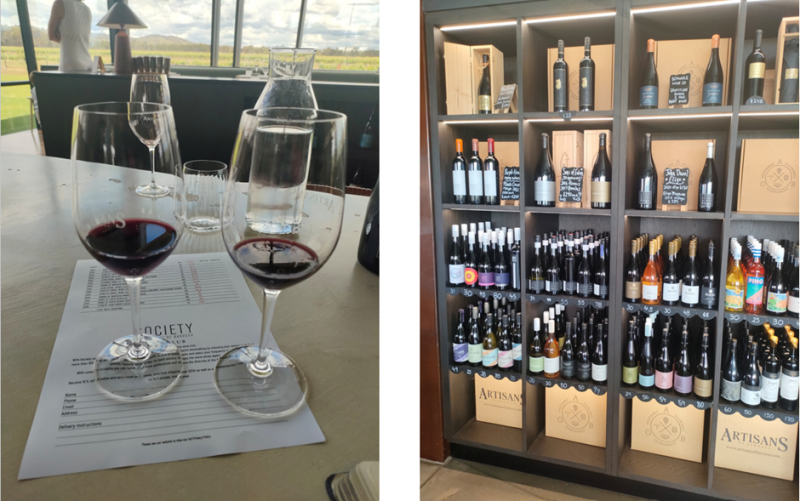
Hobbs of Barossa Gregor 2021 Barossa Shiraz. Founded by Greg and Allison Hobbs, in 1995, Hobbs of Barossa is based on a historic 15 acre Barossa Ranges vineyard with very old vines managed sustainably using organic and bio-dynamic practices. This wine is an Amarone style wine made from hand picked grapes just before full ripeness semi-dried on racks appassimento to intensify flavours without losing acidity. Aged 20 months in oak 50% new. Deep magenta purple in the glass with blackberry, mocha chocolate, vanilla and spice aromas. On the palate it is ripe, rich and oh so velvety, with a lovely cassis-edged chocolate liquor flavour, and a layered harmonious finish. Sui generis!
Lienert Vineyards 2021 Estate Barossa Shiraz. The Lienert Vineyards are on a family farm on the western ridge of Barosa Valley which was planted in grapes from 2001. The first crops were sold to Penfolds, some ending up in their St Henri wine. Eventually two Lienert brothers, viticulturist John and winemaker James started making their own wine from the best of their own grapes. The wine is deep magenta purple in the glass with aromas of ripe red and black fruits, pepper spice and a herbal edge. On the palate a delightful balance of lushness and freshness with black and blue fruit predominating, excellent length, so drinkable.
Sons of Eden Stauros 2016 Barossa Mourvedre. Made from a single vineyard on ancient soils that host rare stone-crystal crosses known as Staurolite. Hand picked grapes were destemmed and crushed into a small rotating oak barrel fermenter for a slow controlled ferment with extended skin contact. Then pressed and aged in a large format oak vessel for 20 months. Deep ruby with slight garnet on the edge and a brooding nose of dark cherry, bramble tobacco and sous-bois. On the palate morello cherry, red and black bramble fruit, some spice and a mineral edge under the soft tannin spine, long and balanced.

View from the vines back to the Artisans of Barossa outdoor dining area
No rational person could taste that range of wines and conclude that Barossa is passe. Yes, there were some big muscular wines among them, but all had finesse. I was becoming convinced that Barossa wines showcase a successful melding of tradition with innovation. But I had one more visit to make.
Two Hands Wines was founded in 1999 with the aim of crafting the best Shiraz in the world, showcasing regional diversity across Australia. The first vintage was produced the following year from just 17 tons of fruit and a modest $30,000 investment. In 2004 a state-of-the-art winery designed for small batch vinification to preserve terroir expression was established along with the cellar door Kraehe House. The wines quickly gained international acclaim, including 10 consecutive years in Wine Spectator’s Top 100 by 2012.
Two Hands is currently owned by founder Michael Twelftree and Pierre-Henri Morel who joined in 2014 as General Manager. Along the way Two Hands has established its own vineyards to add to the original Coach House vineyard in Greenock (from 2002) and 5 acres of Shiraz was planted next to the cellar door in 2005. The Holy Grail Vineyard was planted from 2016 with 22 individual blocks each with its own unique microclimate, and specific planting decisions such as clone, orientation or training system to best suit that block. Sustainability is a critical part of the estate’s ethos with regular inter-row mulching with straw between vines, inter-row planting, generous compost applications and use of sap flow technology[1] to ensure optimised soil health and soil moisture.
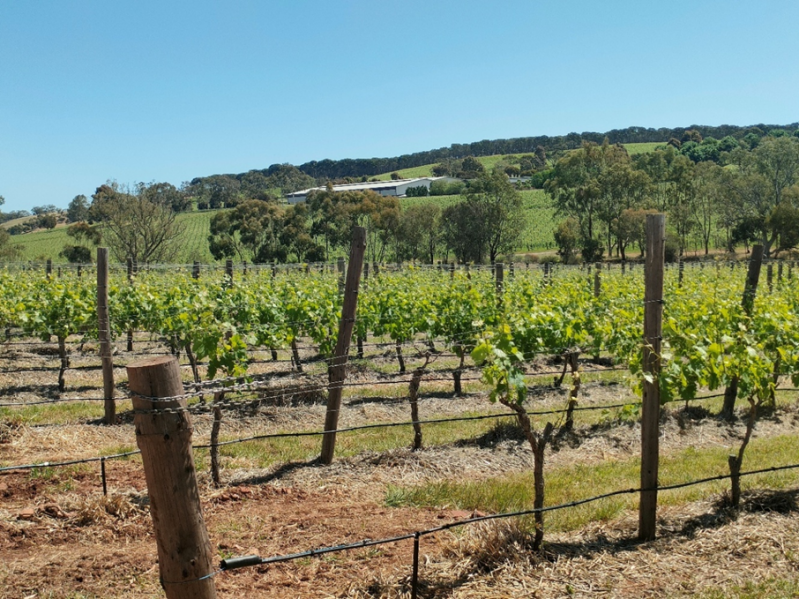
Straw mulch between rows in the Kraehe Vinyeard next to the cellar door
There are four main wine levels produced. The entry level Picture Series are still serious wines intended to over deliver on quality but with quirky fun labels: “the aim is to bring a smile to your face when you pick up the bottle, reminding you that wines should be approachable and of course…fun.” The Garden Series named after family members are made from premium Shiraz from six different Australian wine-growing regions, vinified and matured identically to bring focus to the unique characteristics of each region. The Single Vineyard Series are supreme examples of Shiraz expressing the specific place where they are grown. These are named after the block, road, and town they come from. Finally, the flagship series are best barrel selections from the best fruit parcels.
My visit was hosted by Luke Willis who has a long background in the wine trade, a Bachelor in Wine Marketing and has been the Direct-to-Consumer Sales Manager at Two Hands for the last three and a half years. We tasted through examples of all levels before proceeding to tour the winery.
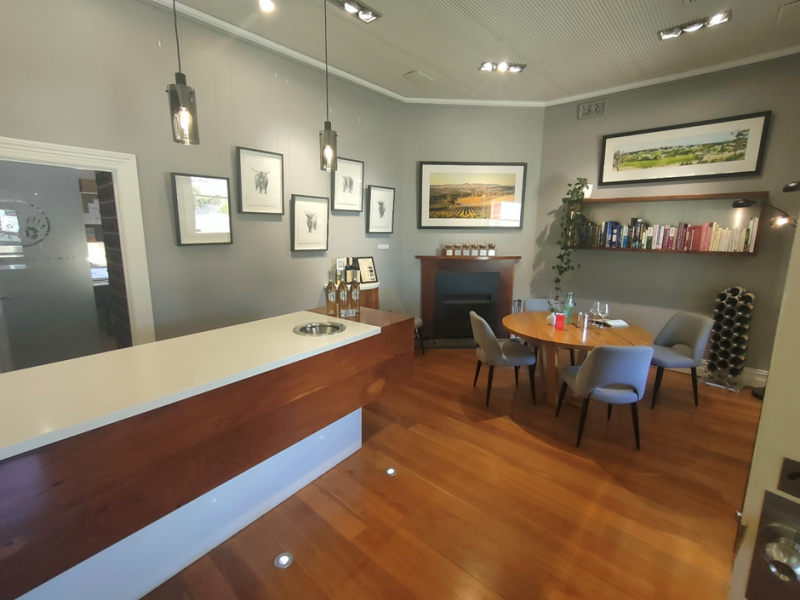
The cosy corner of Two Hands’ Kraehe House cellar door where we had our tasting
First up was The Boy 2024 Eden Valley Riesling. Sourced from 100-year-old dry grown vines on Mengler’s Hill, handpicked and crushed with only the free run juice fermented slowly in stainless after cold settling, matured for three months, filtered and fined before bottling. Light straw in the glass with bright aromas of lime fruit and a hint of jasmine. It has a lovely soft, juicy and clean mouthfeel with a firm acid spine under layers of lime citrus and apple, and a quiet power in the long finish that avoids any hint of austerity.
Gnarly Dudes 2024 Barossa Shiraz. Handpicked fruit, crushed and fermented in open top fermenters with regular pump overs during fermentation, pressed, racked to barrel and matured 12 months in French oak 13% new in separate batches before final blending and bottling. Inky purple in the glass with aromas of black and blue fruit, black pepper, tobacco and baking spice. On the palate rich blackberry and dark plum fruit with hints of pepperoni, supported by supple tannins. Medium to full-bodied and good persistence on the finish.

Display of the different Single Vineyard soils
Brave Faces 2023 Grenache Mourvedre and Shiraz. Each fruit batch was destemmed and separately fermented in open top fermenters, the Grenache with 20% whole bunch inclusion. The Shiraz was lightly pumped over while the Grenache and Mourvedre were lightly plunged after an initial cold soak. Matured for 12 months in French oak, 10-15% new. Light ruby in the glass with a nose of bright red fruits, pot-pourri and lapsang souchong. On the palate medium bodied with soft silky tannins, nice freshness and flavours of juicy red fruit edged with baking spice, good length, easy drinking.
Max’s Garden 2022 Heathcote Shiraz. The first of four Garden series tasted, deep purple in the glass with aromas of black fruit, sous-bois, soy sauce and spice. Medium bodied with soft supple tannins, blue and black fruit flavours edged with liquorice and distinct spicy notes, quite long. Approachable now but not yet at its best.
Charlie’s Garden 2022 Eden Valley Shiraz. From the best barrels of Eden Valley Shiraz sourced from the Mengler’s Hill vineyard. Magenta purple in the glass with distinct floral notes on the nose of violets and rose, black fruits, and some fresh herbs. On the palate sweet black and blue fruit dominate, supported by fine silky tannins and a long finish.
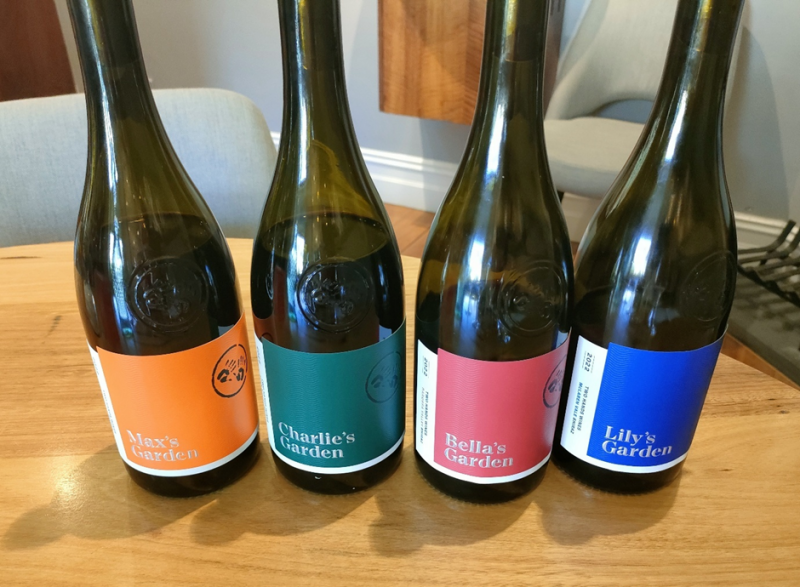
The Garden Series wines I tasted
Bella’s Garden 2022 Barossa Valley Shiraz. From the best barrels of Shiraz across the Barossa Valley. Inky purple in the glass with concentrated aromas of dark berries, chocolate, clove and pepper spice, liquorice and some herbal notes. Rich, full bodied, and opulent with plush berry fruits, dark chocolate and Christmas cake spices and a long velvety finish.
Lily’s Garden 2022 McLaren Vale Shiraz. The best from the McLaren Vale vineyards. Ruby purple in the glass with a distinctly pepper spicy aroma overlaying Doris plum and blueberry fruits with a hint of smoke. The palate is quite rich and full-bodied but the dark cherry, plum and berry flavours have a spicy and savoury edge complexity giving way to a firm dry finish. Needs time or drink now with a spicy slow cooked brisket.
From the Single Vineyard Series I tasted the 2021 Ziggy’s Block Barossa Cabernet Sauvignon which was the first non-Shiraz wine added to the lineup since 2014. One small parcel was sourced from a grower’s vineyard in the western Barossa village of Greenock. The grapes were handpicked, crushed and destemmed into a single open top fermenter, spending 10 days on skins with 2-3 pump overs per day. The free run and pressings were combined in tank and then racked to barrel for malo and maturation 18 months in French oak up to 50% new before bottling with minimum fining and no filtration. Dark ruby in the glass with a blackberry plum and cassis nose, some minty eucalypt and a hint of tobacco. Rich ripe and concentrated on the palate with lush cassis and Doris plum flavours and a hint of vanilla. The tannins are firm but supple, the finish long and layered. Should appeal to lovers of Californian Cabernet.
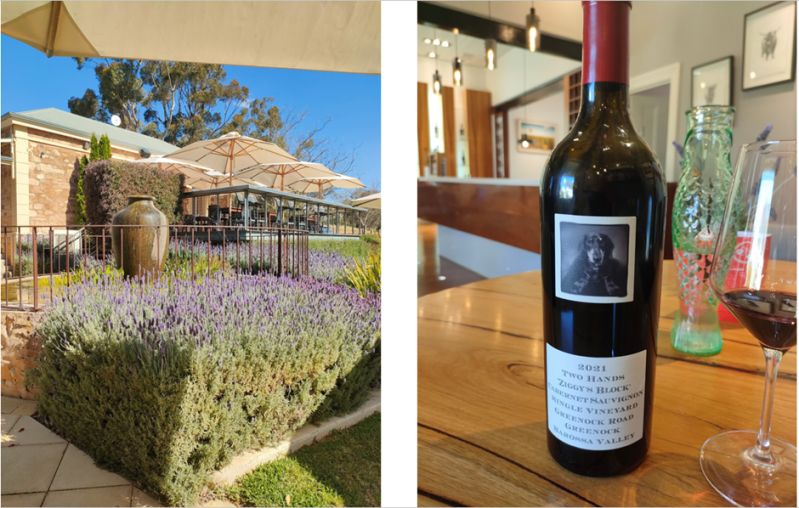
Left. Approaching the cellar door from the rear. Right. Ziggy’s 2021 Cabernet Sauvignon
2020 Ares Shiraz. The original flagship wine made from the best Shiraz barrels across the Estate in a low-yielding high-quality vintage, this wine spent 20 months in French oak 50% new. Ruby purple in the glass with a fragrant nose of violets, blackberries, plums, milk chocolate and liquorice. Rich and powerful on the palate with ripe and concentrated plum and berry fruit, mocha chocolate, crushed gravel and spice flavours. The tannins are fine, silky and pervasive and the wine finishes incredibly long. This wine is built to last decades.
Following this excellent tasting Luke gave me a tour of the modern winery.
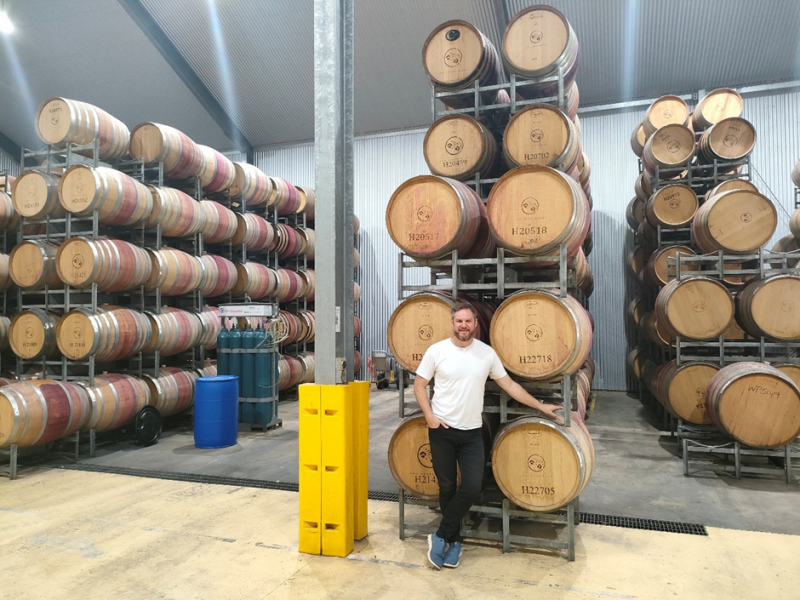
Luke, Two Hands DTC Manager in the barrel room
In general, apart from the Picture Series, the Two Hands wines were big and powerful, but very far from homogenous. The Garden Series tasting faultlessly exemplified the different regional characteristics. In this Two Hands achieves its purpose. These were, in the main, serious wines that invited contemplation or demanded richer food. Perhaps not wines to quaff away an afternoon to the second or third glass, but definitely wines to be shared over a good dinner and conversation.
Yes, there are light reds that are easy to drink more than one glass of on a hot day outside, and this may be more fashionable. But is there not the risk that these too can slip into forgettable homogeneity, just as easily as Parkerisation risked bold ripe oak driven reds that lacked regional character and diversity? And quite frankly I would rather drink one glass of profound, regionally expressive wine and be satisfied, than two or three glasses that go down as if they were mineral water.
Fashions come and go. These Barossa wines might not entirely suit the current fashion, but they have personality and confidence, and they are selling. I am persuaded that Barossa winemaking is in excellent shape.
[1] Sap flow technology electronically monitors the movement of water through the vine’s xylem using non-invasive sensors on the vine trunk or stem. These allow precise delivery to the vine based on actual vine stress, not just soil moisture or weather forecasts and delivers 30-40% reduction in vineyard water use.
If you enjoyed this weekly blog, you can subscribe for free using the contact form, or just email info@wineinsights.org. To see all my daily content follow me on Facebook.
I am considering leading a small group South Australia wine tour next year which will take in the Barossa Valley, McLaren Vale and Adelaide Hills, possibly Coonawarra as well. If this is something that might interest you, please indicate your interest using the contact form or email as above.
Add comment
Comments